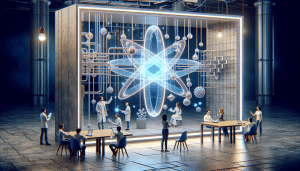Discover Ways Artificial Intelligence Impacts Your Everyday Life
Aiden Foster August 26, 2025
Artificial intelligence isn’t just a buzzword from science fiction. Explore how AI quietly shapes daily routines, from smartphones to smart homes. This engaging guide reveals surprising details and practical considerations, making it easier to understand the tech influencing your world.
The Rise Of Artificial Intelligence In Daily Life
Artificial intelligence (AI) is increasingly present in daily routines. From voice assistants to predictive text on phones, these technologies are powered by complex algorithms. Many people turn on their phones each morning and are greeted with personalized news updates or weather forecasts, all thanks to AI. The influence of artificial intelligence doesn’t require complicated setups—much is embedded in technology already used. Deep learning, machine learning, and natural language processing are just some of the core AI fields behind these advancements. Each method allows devices to ‘learn’ and adapt, often making life more convenient without us even noticing.
Smart devices are rapidly advancing, and much of this evolution is driven by machine learning. For example, wearable technology can track health metrics such as sleep cycles or heart rate, providing recommendations for better health. In retail, artificial intelligence enables personalized shopping experiences by analyzing purchasing behavior. These tailored suggestions can make online browsing faster and more relevant. The development of recommendation engines—used by streaming services, online retailers, and even social media—has been one of the most visible uses of AI, improving entertainment and shopping habits worldwide (see https://www.nist.gov/artificial-intelligence).
One area where artificial intelligence really shines is automation. In the home, smart assistants can learn routines—turning off lights, adjusting thermostats, or reminding users about schedules. The same AI can detect patterns in day-to-day activities, helping to optimize energy use and security. Machine learning helps these systems get better over time, ensuring predictive functions become more personalized and accurate. As the number of connected devices increases, so does the influence of AI over home environments, all while remaining nearly invisible to the end user.
AI And Personalized Recommendations
Recommendation systems rely heavily on artificial intelligence, blending user history, preferences, and complex algorithms to offer content uniquely suited to individuals. Think of scrolling through a film or music streaming platform: the selections shown are not random but curated by AI. These systems analyze not only what has been watched or listened to but also how long items were engaged with, favorite genres, and even skipped tracks, to continually refine their suggestions. Most users find that the suggestions improve the more they interact with these platforms, making discovery easier and more satisfying.
In the world of e-commerce, recommendation engines fueled by machine learning shape online shopping experiences. Web stores analyze browsing habits, brand preferences, and purchase histories to surface products that match personal taste. This not only enhances user satisfaction but can also help reveal deals or items that might otherwise be overlooked. Even when customers abandon shopping carts, AI-driven systems can gently remind them with relevant follow-ups, providing seamless and intuitive online journeys. These systems continuously learn, evolving with every interaction (https://www.edx.org/learn/artificial-intelligence).
Artificial intelligence powers not just entertainment and shopping, but also news and social media feeds. Through real-time analytics and user-engagement metrics, AI tailors information flow, highlighting articles from trusted sources or promoting posts related to current interests. Such personalized curation keeps content fresh and relevant. However, it also raises important questions about information bubbles and exposure to diverse ideas, making transparency and ethical AI a rising concern for both developers and users.
The Evolution of Smart Home Technology
Smart home technology is becoming increasingly intuitive due to artificial intelligence. Devices like thermostats, security cameras, and lighting can ‘learn’ daily patterns without manual programming. For example, a smart thermostat might begin to adjust settings automatically after observing household routines. The ability to recognize personal preferences means less time is spent on repetitive adjustments, and more energy savings is achieved through optimization. AI also enables voice-activated assistants to manage everything from music selection to calendar scheduling, all with simple voice commands.
Security is another frontier benefiting from AI. Modern security systems use video analytics to distinguish between residents, visitors, and potential threats, reducing false alarms. Some smart locks and doorbells now employ facial recognition, allowing entry based on biometric identifiers. These applications rely on advances in deep learning, which makes identification more accurate and efficient. With these tools in place, managing home safety and access feels both futuristic and practical (reference: https://cs.stanford.edu/people/eroberts/courses/soco/projects/1998-99/artificial-intelligence/smart.html).
Household efficiency further improves as AI applications integrate with more areas—dishwashers, lawn sprinklers, washing machines. Usage data is analyzed to recommend maintenance or optimize settings, lengthening appliance life and reducing resource use. Smart home platforms learn as they go, streamlining household routines while freeing up time. It’s a glimpse of a connected future where automation means less hassle for residents and a smoother day-to-day experience overall.
AI-Driven Health And Wellness Tools
Health applications of artificial intelligence can be seen everywhere from wearable fitness trackers to telehealth services. Fitness trackers use machine learning to interpret data collected from sensors across the body, providing guidance on exercise goals and sleep quality. These devices learn from past behaviors and adapt recommendations, helping many users meet their health targets. The technology is not just for athletes—regular users benefit from personalized insights designed to encourage a healthier lifestyle.
Telehealth systems leverage artificial intelligence to manage appointments, reminders, and even initial triage for some conditions. Chatbots, powered by natural language processing, provide basic symptom analysis and support. While they don’t replace doctors, they can guide patients toward suitable next steps and remind them about prescriptions or follow-ups. Increased automation in healthcare can improve accessibility for underserved populations, reducing wait times and overcoming physical barriers to care (see: https://www.mayoclinic.org/artificial-intelligence-in-health-care).
Even mental well-being apps are adopting artificial intelligence. Some use chatbots to offer conversational support, helping users process feelings or cope with stress. AI-driven meditation and mindfulness tools personalize sessions and build adaptive routines by monitoring sleep and mood. These applications highlight the expanding role of AI in holistic health management, making expert guidance more accessible and tailored without the need for traditional appointments.
Transportation And Navigation Powered By AI
Transportation has transformed thanks to artificial intelligence. AI coordinates route planning in ride-hailing apps, selecting optimal paths by analyzing traffic data, road closures, and current demand. Public transit now often relies on predictive systems to adjust bus or train schedules, increasing on-time performance and efficiency. AI’s real-time analysis keeps people moving smoothly across busy cities, saving time while reducing congestion for everyone.
Self-driving car development remains one of the most ambitious uses of AI. Dozens of sensors and cameras monitor surroundings, while deep learning algorithms make instant decisions under changing conditions. Although fully autonomous vehicles are still emerging, semi-automated features such as lane assistance, adaptive cruise control, and emergency braking can already be found in mainstream cars, demonstrating practical everyday benefits. These advances may enhance road safety and broaden mobility options as technology matures (source: https://www.nhtsa.gov/technology-innovation/automated-vehicles-safety).
Personalized navigation is also powered by artificial intelligence. GPS apps learn travel preferences over time, recommending alternate routes or even ideal departure times based on historic traffic trends. These smart maps provide estimated arrival times that continuously update based on real-world changes, improving accuracy with each use. Such features illustrate the subtle but powerful role AI holds in simplifying and enhancing daily journeys.
Considerations And Ethics In Everyday AI
The growing presence of artificial intelligence in routines comes with significant ethical considerations. Issues such as privacy and data security are top of mind, especially as more devices collect sensitive information. Developers must balance innovation with safeguards, ensuring that end users have control and transparency over how information is used. Many technology companies are beginning to implement ethical guidelines and provide more detailed privacy policies to address these challenges proactively (see https://plato.stanford.edu/entries/ethics-ai/).
Algorithmic bias is another concern. As AI learns from historical data, it may inadvertently reinforce existing societal biases unless carefully monitored. Developers are investing in creating more representative training data and regularly auditing systems. Ethical AI also emphasizes the importance of inclusivity, fairness, and accountability in automated decisions. It’s a rapidly evolving area where interdisciplinary collaboration is increasingly necessary—combining insights from technology, law, sociology, and human rights advocates.
User awareness is a key protection. Educational efforts aim to help people recognize how AI influences recommendations or decisions, encouraging informed interactions. As artificial intelligence evolves further, conversations about responsible use, regulation, and open communication will only become more relevant. Understanding the technology behind daily conveniences makes it possible to navigate a connected world more confidently and thoughtfully.
References
1. National Institute of Standards and Technology. (n.d.). Artificial Intelligence. Retrieved from https://www.nist.gov/artificial-intelligence
2. edX. (n.d.). Artificial Intelligence Courses. Retrieved from https://www.edx.org/learn/artificial-intelligence
3. Stanford University. (n.d.). Artificial Intelligence and Smart Homes. Retrieved from https://cs.stanford.edu/people/eroberts/courses/soco/projects/1998-99/artificial-intelligence/smart.html
4. Mayo Clinic. (n.d.). Artificial Intelligence in Health Care. Retrieved from https://www.mayoclinic.org/artificial-intelligence-in-health-care
5. National Highway Traffic Safety Administration. (n.d.). Automated Vehicles for Safety. Retrieved from https://www.nhtsa.gov/technology-innovation/automated-vehicles-safety
6. Stanford Encyclopedia of Philosophy. (n.d.). Ethics of Artificial Intelligence and Robotics. Retrieved from https://plato.stanford.edu/entries/ethics-ai/








